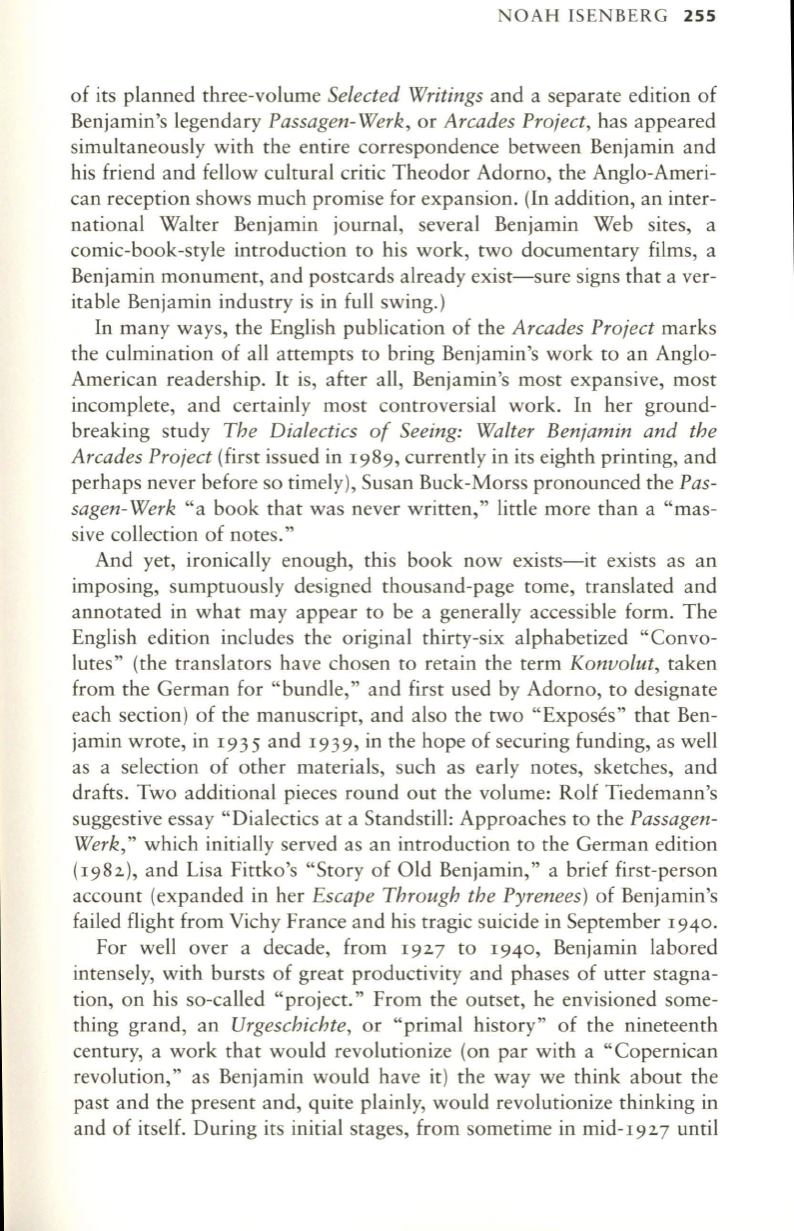
NOAH ISENBERG
255
of its planned three-volume
Selected Writings
and a separate edition of
Benjamin's legendary
Passagen-Werk,
or
Arcades Project,
has appeared
simultaneously with the entire correspondence between Benjamin and
his friend and fellow cultural critic Theodor Adorno, the Anglo-Ameri–
can reception shows much promise for expansion. (In addition, an inter–
national Walter Benjamin journal, several Benjamin Web sites, a
comic-book-style introduction
to
his work, two documentary films, a
Benjamin monument, and postcards already exist-sure signs that a ver–
itable Benjamin industry is in full swing.)
In
many ways, the English publication of the
Arcades Project
marks
the culmination of all attempts to bring Benjamin's work
to
an Anglo–
American readership.
It
is, after all, Benjamin's most expansive, most
incomplete, and certainly most controversial work.
In
her ground–
breaking study
The Dialectics of Seeing: Walter Benjamin and the
Arcades Project
(first issued in 1989, currently in its eighth printing, and
perhaps never before so timely), Susan Buck-Morss pronounced the
Pas–
sagen-Werk
"a book that was never written," little more than a "mas–
sive collection of notes."
And yet, ironically enough, this book now exists-it exists as an
imposing, sumptuously designed thousand-page tome, translated and
annotated in what may appear to be a generally accessible form. The
English edition includes the original thirty-six alphabetized "Convo–
lutes" (the translators have chosen to retain the term
Konvolut,
taken
from the German for "bundle," and first used by Adorno, to designate
each section) of the manuscript, and also the two "Exposes" that Ben–
jamin wrote, in 1935 and 1939, in the hope of securing funding, as well
as a selection of other materials, such as early notes, sketches, and
drafts. Two additional pieces round out the volume: Rolf Tiedemann's
suggestive essay "Dialectics at a Standstill: Approaches to the
Passagen–
Werk,"
which initially served as an introduction
to
the German edition
(1982), and Lisa Fittko's "Story of Old Benjamin," a brief first-person
account (expanded in her
Escape Through the Pyrenees)
of Benjamin's
failed flight from Vichy France and his tragic suicide in September 1940.
For well over a decade, from 1927 to 1940, Benjamin labored
intensely, with bursts of great productivity and phases of utter stagna–
tion, on his so-called "project." From the outset, he envisioned some–
thing grand, an
Urgeschichte,
or "primal history" of the nineteenth
century, a work that would revolutionize (on par with a "Copernican
revolution," as Benjamin would have it) the way we think about the
past and the present and, quite plainly, would revolutionize thinking in
and of itself. During its initial stages, from sometime in mid-1927 until


